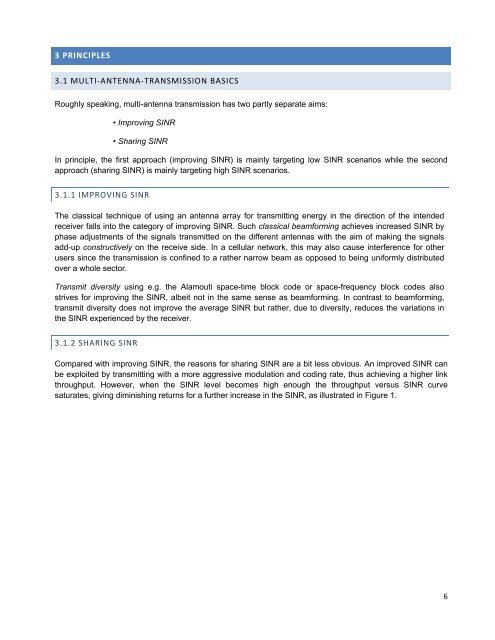MIMO Transmission schemes for LTE and HSPA Networks, 3G
MIMO Transmission schemes for LTE and HSPA Networks, 3G
MIMO Transmission schemes for LTE and HSPA Networks, 3G
- No tags were found...
You also want an ePaper? Increase the reach of your titles
YUMPU automatically turns print PDFs into web optimized ePapers that Google loves.
3 PRINCIPLES3.1 MULTI‐ANTENNA‐TRANSMISSION BASICSRoughly speaking, multi-antenna transmission has two partly separate aims:• Improving SINR• Sharing SINRIn principle, the first approach (improving SINR) is mainly targeting low SINR scenarios while the secondapproach (sharing SINR) is mainly targeting high SINR scenarios.3.1.1 IMPROVING SINRThe classical technique of using an antenna array <strong>for</strong> transmitting energy in the direction of the intendedreceiver falls into the category of improving SINR. Such classical beam<strong>for</strong>ming achieves increased SINR byphase adjustments of the signals transmitted on the different antennas with the aim of making the signalsadd-up constructively on the receive side. In a cellular network, this may also cause interference <strong>for</strong> otherusers since the transmission is confined to a rather narrow beam as opposed to being uni<strong>for</strong>mly distributedover a whole sector.Transmit diversity using e.g. the Alamouti space-time block code or space-frequency block codes alsostrives <strong>for</strong> improving the SINR, albeit not in the same sense as beam<strong>for</strong>ming. In contrast to beam<strong>for</strong>ming,transmit diversity does not improve the average SINR but rather, due to diversity, reduces the variations inthe SINR experienced by the receiver.3.1.2 SHARING SINRCompared with improving SINR, the reasons <strong>for</strong> sharing SINR are a bit less obvious. An improved SINR canbe exploited by transmitting with a more aggressive modulation <strong>and</strong> coding rate, thus achieving a higher linkthroughput. However, when the SINR level becomes high enough the throughput versus SINR curvesaturates, giving diminishing returns <strong>for</strong> a further increase in the SINR, as illustrated in Figure 1.6
















